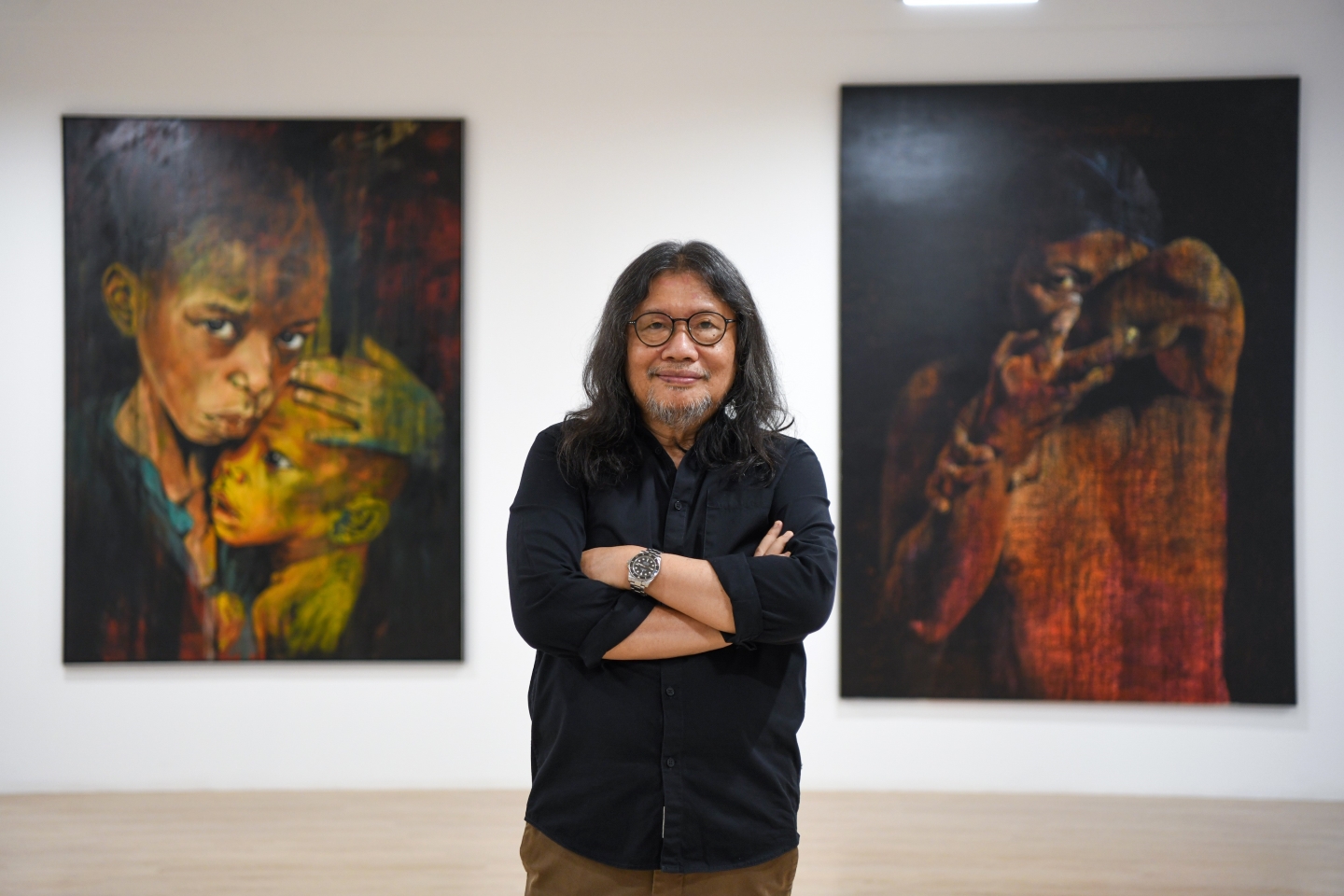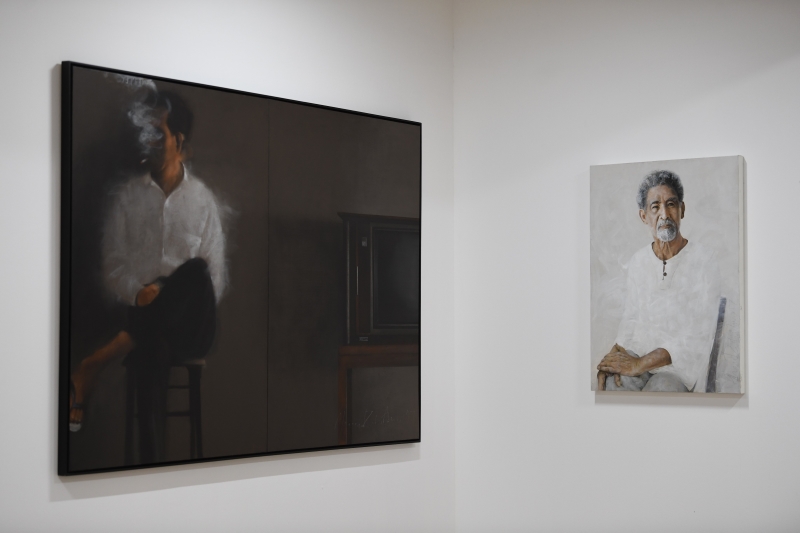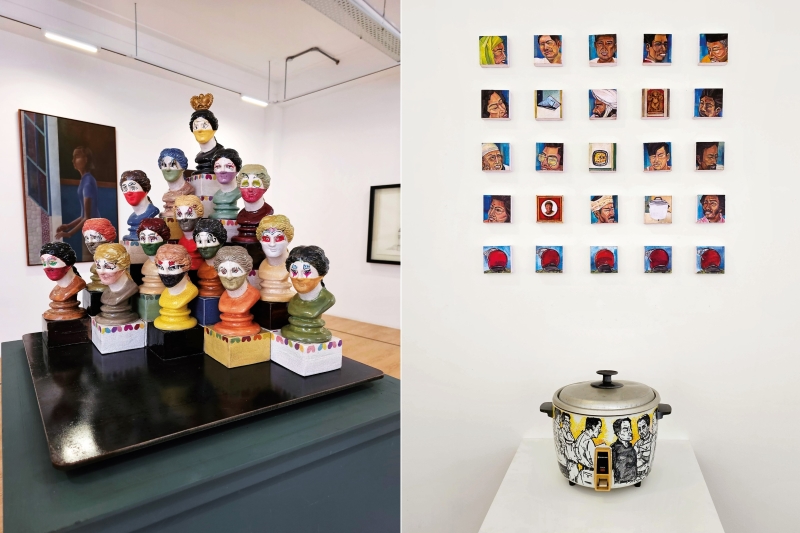
Pakhruddin Sulaiman photographed against several large-scale artworks by Bayu Utomo Radjikin (Photo: Low Yen Yeing/ The Edge Malaysia)
In a poignant reflection on Prime Minister Datuk Seri Anwar Ibrahim’s tumultuous political journey, a new exhibition serves as testament to his resilience and the enduring spirit of Reformasi.
While memories of the Bersih rallies remain vivid, the movement that emerged in the late 1990s with Anwar’s abrupt removal as deputy prime minister amid unprecedented accusations, remains somewhat elusive to many.
Enter Pakhruddin Sulaiman, affectionately known as Pakha, whose extensive art collection chronicles this transformative era. Now showcased at the new Ur-Mu 2, a second art space following the original Ur-Mu (short for ‘urban museum’) in Bukit Bintang by architect, collector and connoisseur Dr Tan Loke Mun, Tubuh: Selected artworks by 15 Malaysian contemporary artists from the Pakha Sulaiman Collection puts forward an in-depth exploration of the Reformasi movement’s impact through the lens of contemporary art.
The exhibition brings together almost 100 figurative art pieces produced during the 1990s and early 2000s, and they serve as powerful conduits for and reflections on social, religious, political and cultural discourse within the country and on the global stage. “It was the same time I started amassing artworks in a big way together with my late wife Fatimah Sulaiman and I would consider this period the golden age of art collecting,” says the lawyer, who graduated in 1982 from the University of London, when met at the gallery.
Many of the pieces — which include sculptures, drawings, paintings, mixed media works, ceramics, photographs and digital prints — have remained unseen by the public since their acquisition, lending a rare and exclusive quality to the show. Among them are intimate portraits, some of which were gifted to Pakha by the artists themselves as birthday presents or tokens of gratitude for his support.
ahmad_fuad_osman_recollection_of_long_lost_memory_2_1.jpg

“As a collector, I believe it’s our responsibility to share our collection with the public. Without such sharing, these artworks risk languishing unseen and unappreciated, denied the opportunity to be enjoyed by a wider audience.”
When selecting the pieces for the exhibition, the main criterion was that they had to resonate deeply with Pakha. It must draw him in upon first glance and continue to fascinate with each subsequent viewing, all while reflecting the multifaceted nature of the era it represents.
“Take the works of Ahmad Fuad Osman, for example. They speak volumes about the Reformasi movement and the rift between Dr M and his then-timbalan, who is the current PMX. Given that Malaysia’s political landscape is still evolving, many of these artworks remain profoundly relevant for today’s generation. They offer valuable insights into the genesis of this conflict.
“As you navigate through the exhibition,” Pakha continues, “you’ll notice that it culminates with a striking portrait of Anwar, sporting a black eye, positioned alongside (current deputy prime minister) Datuk Seri Ahmad Zahid Hamidi’s piece titled Tiang Seri. In Malay architectural symbolism, the tiang seri serves as the foundational pillar that upholds the entire structure. Here, Fuad draws a parallel, likening Zahid’s role to that of tiang seri Melayu. Unfortunately, due to height constraints at Ur-Mu 2, the entire artwork could not be displayed vertically. However, the current installation inadvertently highlights the instability depicted in the lower portion, mirroring the precariousness of the present political situation.”
The painting depicting Anwar’s assault holds particular significance as it was loaned to Fuad’s controversial 2019 exhibition At The End Of The Day Even Art Is Not Important (1990-2019) at the National Art Gallery. However, it was removed in January the following year along with three other works. Equally important are Fuad’s Recollections of Long Lost Memories, a series of 71 monochromatic archival photographs chronicling the history of the Malay world. It spans the British colonial rule in the mid-1800s to the racial issues of the 1970s. Each photograph amusingly includes an intruder — a bearded, long-haired hippie.
20240423_peo_pakhruddin_sulaiman_18_lyy.jpg

Co-curated by Sarah Abu Bakar, the show features six rooms. The walkthrough begins with a section where the figures are stylised, reflecting Islamic principles that forbid the realistic depiction of human figures. Here, sculptures portraying the tough lives of fishermen and the five pillars of Islam by Mad Anuar Ismail stand prominently alongside a portrait of Malaysian actor Eman Manan, whom Pakha refers to as the last Malay hero.
In the next room, silat takes centre stage. “This is a revolutionary figure painting where you see two people seemingly fighting but upon closer inspection, it’s the artist Amron Omar battling against himself. It’s called Pertarungan and all his paintings adhere to the same theme, with the only difference being the year and medium. This type of silat works are often only created by Malay Muslims from the Nusantara region. The philosophy behind it embodies the concept of the ultimate jihad, the struggle or fight against oneself.”
Pakha’s collection extends beyond finished artworks to include studies and sketches by artists, sometimes spanning up to two years before a piece is finalised. “I don’t only collect big pieces; I value the entire creative process. Art collecting is not just aggregating masterpieces but also the whole work of germinating [an] idea and translating it onto paper before being realised on canvas. When you put them together, they symbiotically strengthen each other.”
Jalaini Abu Hassan’s bomoh series was particularly enjoyable to experience, especially given his use of writing to complement the work. His pieces are multifaceted and consistently fascinating. Additionally, there are several large-scale artworks by Bayu Utomo Radjikin depicting themes of war and famine, with children featuring prominently. Despite being created in the early 1990s, these pieces remain relevant today. Alongside them are paintings of male protagonists in warrior gear.
ur-mu_exhibition.jpg

The show also includes outstanding works by women artists, including Nadiah Bamadhaj, who resides permanently in Yogyakarta, Indonesia. Additionally, German-trained Noor Mahnun Mohamed, playful Shia Yih Yiing and ceramic artist Umibaizurah Mahir Ismail contribute to the diverse range of works on display.
“When I began collecting some 30 years ago, I couldn’t afford pieces by established artists because I come from a humble background, not a wealthy family. So, I started collecting artworks by young and emerging artists. Unbeknown to me at the time, this gradually evolved into an important commentary on the 1990s. This is khazanah negara (national treasure), don’t you think?”
Pakha believes his collection has the potential to spark meaningful discussions and even debate about the role of art in society. Modern art, he contends, goes beyond mere aesthetics to explore ideas that challenge our conscience. He hopes that the younger generation will respond positively to this as the essence of art lies in provoking responses and fostering dialogue.
“It would be sort of a strike back by private collectors such as Ng Seksan, Dr Steve Wong and Bingley Sim, who are planning to unveil their collections to the public. They are all part of the 30 Art Friends, collectors from Malaysia and Singapore, who banded together for art’s sake and I was the head of the former. We have produced coffee table books in the past.”
Other artists featured in the exhibition include Ahmad Zakii Anwar, Anurendra Jegadeva, Noor Azizan Rahman Paiman, Raja Shahriman Raja Aziddin, Wong Hoy Cheong and Zulkifli Yusoff.
This is Pakha’s second exhibition after For the Imaginary Space at the former The Edge Galerie in 2014, which featured contemporary works by Malaysian sculptors and installation artists.
'Tubuh: Selected artworks by 15 Malaysian contemporary artists from the Pakha Sulaiman Collection' at Ur-Mu 2 is on until May 2025. The gallery, located within The Toffee, a new art hub in the city with a soon-to-open F&B outlet, exhibition space, art museum and roof-top garden. The Toffee is at 2, Jalan Raja Chulan, Kuala Lumpur, and is open from 10am to 8.30pm, with the last entry at 7.30pm, daily except Monday. The entrance fee is RM20. Buy tickets here.
This article first appeared on May 13, 2024 in The Edge Malaysia.


